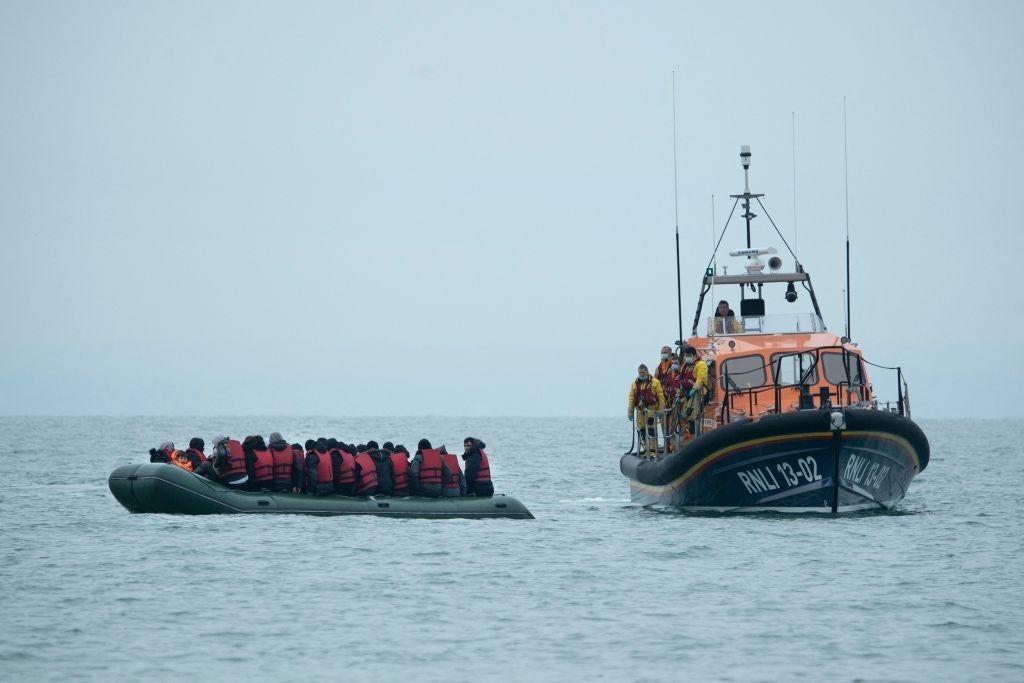
Talk of a refugee crisis in Europe has returned, with the number of small boats carrying asylum seekers across the English Channel reaching record levels in December, just as thousands were trapped on the Poland-Belarus border.
The total number of asylum applications for the whole of 2021 is not yet known, but numbers for the first half of the year were far from extraordinary – 356,495 across Europe, according to the UN High Commissioner for Refugees (UNHCR).
If that number is representative of 2021 as a whole, it would put 2021’s asylum claims at their second-lowest level since 2013, behind only the figure for 2020 (during the height of Covid-19 travel restrictions).
What has become a crisis, as the two big refugee stories of recent months illustrate, is the response of European countries to relatively modest flows of asylum seekers.
Tensions rise as migrants move
The Press Association estimated in September 2021 that small boat crossings of the English Channel for that year were at that point already double the figure for all of 2020. The risks of such crossings, which typically make use of inflatable dinghies to traverse the busiest shipping lane in the world, are enormous. The sinking of a boat in November 2021 was the largest loss of life for a refugee Channel crossing on record, with at least 31 dead.
Meanwhile, Poland dispatched 20,000 border police, armed with water cannons and tear gas, to prevent the entry of several thousand refugees attempting to enter via Belarus, many of them fleeing Iraq’s troubled Kurdistan region. Prevented by Belarussian forces from returning to Belarus, these migrants have remained trapped in the forest as temperatures plummet. At least 21 are dead or missing, according to the Missing Migrants Project.

US Tariffs are shifting - will you react or anticipate?
Don’t let policy changes catch you off guard. Stay proactive with real-time data and expert analysis.
By GlobalDataIn both cases, the danger posed is a result not of a surge in numbers but a lack of safe routes for people to enter the UK or Poland in order to exercise their legal rights to claim asylum. Just 20,000 claimed asylum in the UK in the first half of 2021, compared with 115,000 in Germany and 78,000 in France. Poland, meanwhile, received just 1,115 applications.
The rise in Channel crossings to the UK has been blamed on the gradual elimination of other entry routes. As Liberal Democrat peer Brian Paddick told the House of Lords on 5 January: “There are no safe and legal routes for asylum seekers to get to the UK currently in operation, and you can only claim asylum on UK soil. So what are they supposed to do?”
There is, however, a broader refugee crisis. The number of forcibly displaced people worldwide currently stands at a record 80 million, according to the UNHCR. In the six decades to 2013, that number had never risen past 30 million.
Since 2013, the greatest increases in displaced populations have not been in Europe but across the Global South. The displaced population of Colombia has increased by 4.5 million, Ethiopia by 4.3 million and Yemen by 3.6 million.
Two-thirds of the global displaced population are internally displaced, remaining in their countries of origin. When only counting those that do flee across borders, Germany (1.1 million) is the only European state to number among the top ten destinations, behind Turkey (3.4 million), Uganda (1.3 million) and the US (1.2 million). The other six are all low-income countries.
What, then, shapes refugees’ decisions about when to flee and where to flee to? For those studying these questions, the analysis is typically framed around questions of ‘pull’ factors and ‘push’ factors. Push factors, such as violence or persecution, are what cause someone to leave, while pull factors, such as the prospect of jobs and citizenship, shape where they decide to flee to.
Push factors for fleeing refugees
More than one-quarter of today’s global population of 25.2 million refugees and asylum seekers are from Syria, a country that has been mired in civil war since 2011. One in nine are from Afghanistan, a country that has been in some form of conflict for almost all of the past 40 years. South Sudan and Myanmar, which together make up another 14% of the total, have also been wracked by civil conflict in recent years.
It is therefore unsurprising that most academic studies of refugee and asylum flows find that political violence is overwhelmingly the most important push factor.
This is true both for Europe’s 1990s wave of asylum claims and for more recent waves, and for overall worldwide refugee flows during the latter half of the 20th century. A 2021 study found that the relative significance of terrorism, in particular, as a push factor is likely to be underestimated in most studies because of their omission of internal displacement.
In contrast, studies tend to find that poverty does not play a significant role unless it is combined with violence. Political oppression, violent conflict, human rights abuses and state failure have also been found to be important push factors.
In 2019, poor countries with high levels of political stability had an average refugee outflow of 43 people per 100,000, slightly higher than that of rich and stable countries (28) but well below the level of rich, unstable countries (114). Countries that suffered from both high levels of absolute poverty and high levels of political instability, by contrast, created 3,175 refugees per 100,000 residents.
If violence is the chief motivation for refugees to flee their homes, then the global crisis of displacement may be best explained by the extraordinary rise of civil conflict in recent years.
From 1946 until 2014, only one year (1991) saw more than 50 active civil wars. Since then, every year has breached this threshold, with 2019 and 2020 seeing a record 53 such conflicts. The spike has been driven entirely by an increase in the number of ongoing civil conflicts with foreign involvement, which had never topped eight prior to 2011 but now stands at 25.
Which pull factors influence refugees?
If violence is the chief motivation for refugees to leave their homes, what factors determine where they end up? Here, the simple ‘push-pull’ model has had less success.
Pull factors typically analysed include the refugee acceptance rate, GDP per capita, social provision and the unemployment rate – factors that could indicate a better or worse likelihood of gaining citizenship, employment and a decent standard of living in the new country.
A recent study analysed the relationship between various economic factors and refugee flows to test their influence as pull factors. The study, by South Korean researcher Yoo-Duk Kang, found that countries that are larger in terms of GDP or population tend to attract more refugees, as do countries that have a higher GDP per capita and those that spend more on social services as a share of GDP.
These findings fit broadly with established models of labour migration, but the study also found that asylum seekers are more likely to apply to countries with higher rates of unemployment – the opposite of what would be expected if refugees were choosing their destination based on the prospects of finding work.
What does this suggest? The push-pull framework is derived from neoclassical models of labour market migration. Unlike workers looking abroad for new opportunities, however, refugees rarely have the time, money or power to carefully weigh their options and execute a thought-out plan. This might seem like an obvious point, but it is one that has all too often flown over the heads of economists applying their expertise on traditional labour market questions to the topic of forced migration.
Indeed, even the application of these models to traditional labour markets has come under strain in recent years. A 2021 study by the US National Bureau of Economic Research found that workers in Germany systematically underestimate the wages available to them if they quit their job to find another. The researchers estimated that “between 10% and 17% of employment relationships would not be viable at current wages if workers had accurate beliefs”.
What are gravity factors?
Not all economists, however, have stuck to the orthodox push-pull framework. In fact, economists researching trade flows have long been accustomed to the frustrating refusal of their objects of study to behave in accordance with similar frameworks.
It took until the early 1960s for trade economists to formulate the so-called 'gravity equation', which states that trade between two countries is positively correlated with their incomes and negatively correlated with their geographic distance. This turned out to be an extraordinarily powerful predictor of trade flows but one with little basis in existing economic theory.
The dominant model at the time predicted imports and exports on the basis of the domestic price of different inputs, with countries specialising in what they can produce most cheaply relative to others. Much like the simple push-pull model of refugee flows, this is a highly abstract account with little room for messy realities such as the costs of transport, historical ties or cultural barriers.
Trade economists today have largely incorporated gravity effects into their models, explaining its effects as a consequence of the costs of transport, tariffs and paperwork. When it comes to refugee flows, however, the gravity effects in operation are a little more complicated.
Geographic distance is certainly a major factor, confirmed by numerous studies, but linguistic, cultural and historical ties are also thought to play a role. Why, for instance, are 90% of Laotian refugees in France, compared with just 0.14% in the UK?
A 2005 study into these questions found that migration networks and geographic proximity were both important determinants of where asylum seekers end up, although it found no evidence for the importance of colonial ties, religious similarities or casual contact (such as through tourism, aid or trade).
The importance of migration networks was recently confirmed in a 2020 study by researchers in the UK, which used geolocation data from refugees’ mobile phones to study their movements after arrival in Turkey.
Will the refugee crisis get worse?
The World Bank has estimated that climate change is likely to lead to 143 million people fleeing Latin America, sub-Saharan Africa and South East Asia by 2050, while Professor Norman Myers of the University of Oxford has put the figure at 200 million.
The importance of migration networks suggests that refugees who choose not to remain in the first safe country they arrive in, as is their right under the Refugee Convention, are not necessarily motivated by relative differences in welfare state generosity or the ease of being granted asylum.
Connections to migration networks – family and friends who have moved in the years prior – are likely to be a significant factor. If that is the case, legislation that aims to force refugees to remain in the first safe country they arrive in is likely to harm, rather than help, their integration into society.







